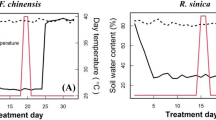Abstract
High irradiances, high air temperatures and low relative humidities characterize the seasonal savannas of central Brazil, locally known as cerrados. In the present study, we investigated the implications to photoprotection of diurnal adjustments in photochemical and non-photochemical processes in five cerrado woody species that differed in photosynthetic capacity and in the duration and extension of the midday depression of photosynthesis. We also evaluated the contribution of photorespiration to minimize the danger of photoinhibition and the potential carbon costs of the operation of this mechanism in response to changes in irradiance levels. Notwithstanding the large differences in diurnal patterns of photosynthesis and in stomatal conductance, four out of the five species showed a tight common linear relationship between net CO2 assimilation rates and transpiration over the large range of environmental conditions that prevailed during typical sunny days at the end of the rainy season. Large reversible decreases in photochemical efficiency were compensated by proportional increases in non-photochemical processes related to photoprotection, irrespective of the prevailing irradiance levels and degree of stomata closure. Light response curves were used to evaluate the relative contribution of photorespiratory CO2 production to electron flow in response to changes in irradiance levels. A large percentage of the electron flow was used to drive photorespiration in light-saturated leaves. In conclusion, an efficient control of photochemical and non-photochemical quenching and adjustments in the partition of electron flow between assimilative and non-assimilative processes alleviated the danger of photoinhibition. However, the results also suggest that losses in potential carbon gain because of high photorespiratory costs could impose strong limitations on leaf carbon balance of cerrado woody species.
Similar content being viewed by others
Author information
Authors and Affiliations
Corresponding author
Additional information
Electronic Publication
Rights and permissions
About this article
Cite this article
Franco, A., Lüttge, U. Midday depression in savanna trees: coordinated adjustments in photochemical efficiency, photorespiration, CO2 assimilation and water use efficiency. Oecologia 131, 356–365 (2002). https://doi.org/10.1007/s00442-002-0903-y
Received:
Accepted:
Published:
Issue Date:
DOI: https://doi.org/10.1007/s00442-002-0903-y




